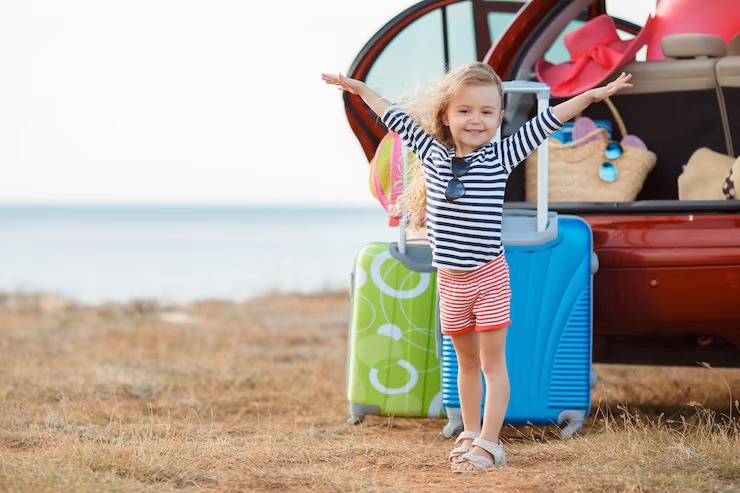Family vacations should create magical memories, not test your patience to its absolute limits. Yet many parents find themselves dreading travel days, anticipating meltdowns at 30,000 feet, or wondering if they’ll survive a cross-country road trip with screaming toddlers in the backseat. The truth is, traveling with children doesn’t have to feel like navigating a minefield. With the right strategies, preparation, and mindset, you can transform potentially chaotic family trips into adventures everyone will treasure.
Last summer, I watched a family of five glide through the Denver airport with remarkable ease. While other travelers looked frazzled, this family moved with purpose—each child carried their own small backpack, parents had everything organized, and when their three-year-old started getting restless, they seamlessly transitioned into a quiet game that kept her engaged until boarding. It wasn’t magic; it was preparation meeting smart planning.

The key to successful family travel lies in understanding that children thrive on routine and predictability, even when experiencing new places. By adapting your travel approach to accommodate their needs while maintaining your sanity, you can create positive experiences that make everyone excited for the next adventure. This comprehensive guide will walk you through every aspect of family travel—from initial planning to handling unexpected challenges—so you can focus on making memories instead of managing chaos.
Pre-Trip Planning: The Key to Sanity
Choosing the Right Destination

Selecting a family-friendly destination sets the foundation for a successful trip. Consider locations that offer a good mix of activities for different age groups, have reliable healthcare facilities, and provide familiar food options. Beach destinations often work well because they offer natural entertainment for kids, while cities with excellent public transportation can make moving around with children much easier. Research the climate, cultural norms, and any special requirements for traveling with minors to your chosen destination.
Accommodation Considerations
Your choice of accommodation can make or break a family trip. Hotels with connecting rooms, suites with kitchenettes, or vacation rentals with multiple bedrooms give families space to spread out and maintain some semblance of normal routines. Look for properties that offer amenities like pools, playgrounds, or kids’ clubs, which can provide entertainment when you need a break. Reading recent reviews from other families will give you insights into how kid-friendly a property really is.
Packing Smart
Create detailed packing lists for each family member at least two weeks before departure. Include essentials like medications, comfort items, extra clothes, and entertainment options. Pack a separate bag with items you’ll need during travel—snacks, wipes, change of clothes, and activities to keep kids occupied. Consider packing cubes or organizing systems that make it easy to find items quickly. Remember that overpacking can create more stress than underpacking, so focus on versatile items that serve multiple purposes.
Involving Kids in the Planning Process
Give children age-appropriate roles in planning your trip to build excitement and cooperation. Let them choose between two or three activities you’ve pre-approved, allow them to pick out new books or small toys for the journey, and have them help pack their own bags with your supervision. This involvement gives them a sense of ownership and makes them more likely to cooperate during the actual trip. Create a visual countdown calendar for younger children so they can anticipate the adventure ahead.
Making Travel Day Easier
Airport Strategies

Arrive at the airport earlier than you normally would—the extra time buffer reduces stress when traveling with children. Most airports offer family security lanes that move more slowly but accommodate the extra time needed for families. Take advantage of early boarding to get settled before the plane fills up. Many airports now have play areas where kids can burn energy before long flights. Research your departure airport’s family amenities in advance, including nursing rooms, play areas, and restaurants with kid-friendly options.
Airport Survival Kit Essentials:
- Snacks (more than you think you’ll need)
- Empty water bottles to fill after security
- Wet wipes and hand sanitizer
- Portable device chargers
- Small first-aid kit
- Entertainment options for different ages
- Comfort items like small blankets or stuffed animals
Airplane Activities
Pack a dedicated travel entertainment kit for each child, but don’t reveal everything at once. Introduce new activities gradually throughout the flight to maintain interest. Coloring books, small puzzles, electronic devices with downloaded content, and quiet games work well. For younger children, consider bringing stickers, small snacks that take time to eat, and picture books. Window clings, magnetic drawing boards, and travel-sized board games can provide hours of entertainment without creating mess or noise that disturbs other passengers.
Managing Meltdowns
Understand that meltdowns are often triggered by hunger, fatigue, overstimulation, or feeling out of control. Prevention is your best strategy—maintain regular meal and snack times, ensure kids get adequate rest, and give them choices when possible. When meltdowns do occur, stay calm and have a plan. Sometimes a change of scenery (like a walk to the airplane bathroom) can reset their mood. Pack comfort items that help your child self-soothe, and don’t be afraid to use screen time as a tool during particularly challenging moments.
Road Trip Survival
Plan stops every 90 minutes to two hours when driving with children. Research rest stops, parks, or attractions along your route where kids can stretch their legs and burn energy. Pack a cooler with healthy snacks and drinks to avoid relying solely on fast food. Create travel bingo games, playlist of favorite songs, or audiobooks appropriate for your children’s ages. Consider leaving very early in the morning or during naptime to maximize peaceful driving hours.
On-Location Sanity Savers
Establishing Routine
Maintain familiar routines as much as possible, especially around meals and bedtimes. Children find comfort in predictability, and keeping some structure helps them adjust to new environments more easily. If your child normally has a bath before bed, continue this routine even if it means using the hotel bathtub. Pack familiar snacks, cups, and comfort items that make new places feel more like home. Flexibility is important, but having some constants helps reduce anxiety and behavioral issues.
Balancing Activities
Plan a mix of kid-focused activities and experiences that adults will enjoy. The key is finding overlap—a cooking class might entertain both parents and children, while a beach day offers relaxation for adults and play opportunities for kids. Avoid cramming too many activities into each day; tired, overstimulated children are more likely to have meltdowns. Build in buffer time between activities and don’t be afraid to skip something if the family needs rest.
Sample Day Structure:
- Morning: High-energy activity when kids are fresh
- Midday: Quiet time or rest at accommodation
- Afternoon: Moderate activity with flexibility
- Evening: Relaxed dinner and early bedtime routine
Utilizing Local Resources
Research family-friendly resources in your destination before arrival. Many cities have excellent children’s museums, parks with playgrounds, or family centers that offer free activities. Local libraries often have story times or quiet spaces where families can regroup. Tourist information centers can provide insider tips on kid-friendly attractions that might not be in guidebooks. Don’t hesitate to ask locals for recommendations—parents often know the best spots for families.
Taking Breaks
Schedule intentional downtime into your itinerary. This might mean spending an afternoon at your accommodation’s pool, finding a park where kids can play freely, or simply having a quiet meal without rushing to the next activity. Adults need breaks too, so consider splitting up occasionally if you’re traveling with a partner—one parent can take older kids to a museum while the other rests with a napping toddler. These breaks prevent burnout and help everyone enjoy the active parts of your trip more fully.
Safety and Health Considerations
Travel Insurance

Invest in comprehensive travel insurance that covers medical expenses, trip cancellations, and lost luggage for the entire family. Children can get sick or injured unexpectedly, and medical costs in foreign countries can be substantial. Some policies also cover pre-existing conditions or pregnancy-related issues. Read the fine print carefully to understand what’s covered and keep policy information easily accessible during your trip. Consider additional coverage for adventure activities or sports if your family plans to participate.
Health Precautions
Schedule a visit with your pediatrician 4-6 weeks before international travel to discuss necessary vaccinations and health precautions. Bring a well-stocked first-aid kit including any prescription medications, fever reducers, anti-diarrheal medication, and basic wound care supplies. Research the quality of healthcare at your destination and locate the nearest hospital or urgent care facility. For international travel, ensure all family members have up-to-date passports and any required visas well in advance.
Emergency Planning
Program important phone numbers into your phone and write them down separately: local emergency services, your country’s embassy or consulate, your travel insurance company, and your home doctor. Teach older children how to identify family members and provide basic information about themselves. Take photos of important documents and store them securely online. Establish a meeting point in case family members get separated in crowded areas.
Staying Connected
Keep devices charged and consider portable battery packs for longer outings. Research international data plans if traveling abroad, or purchase local SIM cards for extended stays. Download offline maps and translation apps before departure. Ensure children understand how to use hotel phones or know your mobile number. For older children, consider providing them with a basic phone or GPS tracker for additional security during busy sightseeing activities.
People Also Ask
What age is best for traveling with kids?
There’s no perfect age, but many families find travel easier once children are walking confidently (around 18 months) and before they become too opinionated about activities (around 8-10 years). However, every child is different, and your family’s comfort level matters most.
How do I keep my toddler entertained on a long flight?
Rotate activities every 20-30 minutes, pack new small toys or books they haven’t seen before, use screens strategically, and don’t forget snacks. Walking the aisle when permitted can also help burn energy.
Should I bring a stroller when traveling?
For children under 4, a lightweight, compact stroller is usually worth the hassle. It provides a place for tired kids to rest, helps you move faster through airports, and gives you storage space for bags and purchases.
How do I handle time zone changes with kids?
Start adjusting sleep schedules a few days before departure, maintain consistent meal times, get sunlight exposure upon arrival, and be patient—children typically adjust to new time zones faster than adults.
What’s the best way to pack snacks for travel?
Pack more than you think you’ll need, choose non-perishable options that won’t create mess, include both familiar favorites and a few new treats, and always have backup snacks in case of delays.
Frequently Asked Questions
Q: How can I prepare my anxious child for flying?
A: Read books about flying together, watch videos of airplanes taking off and landing, visit the airport before your trip if possible, and explain what to expect during each part of the journey. Consider bringing noise-canceling headphones and comfort items